Back about two months ago, Garmin announced their first wrist activity tracker (non-watch) with optical HR capabilities, the Vivosmart HR. The Vivosmart HR was designed to build upon the release of the Vivosmart a year earlier. Essentially it’s a daily activity tracker that doubles-down as a workout HR monitor, as well as doing all the now expected functions around smartphone notifications and the like.
I’ve been using the device the last 45 days or so, thus I’ve got a pretty good understanding of how it works (and where it doesn’t). For this review I was sent a Vivosmart HR from Garmin to try out. After this review, I’ll be sending back the demo unit as usual to Garmin in Kansas and getting my own – just the way I roll.
With that intro out of the way, let’s dive into things.
Unboxing:
First up is the unboxing. There are a few different colors, as well as sizes (bands) of Vivosmart HR models. However, the unboxing will be the same for all of them.
Inside you’ll find a mere three things. The Vivosmart HR, the Vivosmart HR USB charger, and the paper stuffs (manual/legal junk).
Starting with the charging, it’s a proprietary charger used only on the Vivosmart HR that’s designed to charge the unit while ensuring the unit remains waterproof (in general we haven’t seen good luck with micro-USB charging ports on deeply waterproofed devices, long-term).
It simply snaps on, and the lock is pretty secure. From there you can charge it in any USB port on the planet:
Next, the manual. This is only notable because it talks to how to wear the unit, which should be away from the wrist bone. As a general rule of thumb for optical HR sensors – the further away from the wrist bone the better.
Lastly, here’s two looks at Vivosmart HR, don’t worry, we’ll get plenty more shots by the end of this thing.
And in case you were wondering, it weights 30g:
And if you compare it to the Polar A360, you’ll find it’s pretty close to identical on size:
With that, let’s get on with the show.
Daily Activity & Sleep:
Now that everything is all unboxed, we’ll start with the basics – which is around the daily activity tracker components. Then after that we’ll dive into the workout and optical HR sensor pieces.
For daily activity tracking the unit will track steps, sleep, and stairs climbed. It does this using its internal accelerometer and various Garmin algorithms to decide what’s a step, and what’s a false-positive (i.e. cleaning the dishes).
When it comes to steps, the unit will display these on a page on the device that you can swipe to, or set as your default page:
Above you see my total steps for the day, against my goal steps. My goal steps is a dynamically changing metric aimed at getting me to step slightly more than the day before. It changes a little bit each day (either up or down), so a single large day (low or high) won’t cause a massive drop. You can always override the goal too, should you like.
Once I hit my goal steps for the day I’ll get a small fireworks show. It’s like 4th of July, only without the hot dogs, cotton candy, and the neighbor’s house burning down:
So what about step-counter accuracy? In general I find it trends pretty similar to other devices I’ve worn at the same time. Part of the challenge with step-counter accuracy is that each vendor (i.e. Garmin, Nike, Fitbit, Polar, etc…) all do slightly different things which they believe makes for the best possible accuracy. However, sometimes that means certain activities end up being more accurate on one device versus another. Or more specifically, even one person compared to another.
For example, I don’t tend to get any (or more than a handful) of steps while in the shower. Yet others will get hundreds (what are you doing?!?). Same goes for driving. Or washing the dishes. In theory these devices won’t track that, but sometimes it happens for others. I guess I’m just less active in those activities than others are.
Ultimately though – these devices should be used for you to look at trends. For example, if you’re at 9,900 steps out of 10,000 for a day, then just go walk around the block once. Meanwhile, if you’re at 2,000 steps for the day – then it was a lazy day. The unit isn’t likely going to be off by 8,000 steps. Make sense?
Oh, in addition to steps you’ll also get your total walked distance for the day:
And right after distance, you’ll get calories. This is using the optical HR sensor as well for some of these calorie calculations. And further, it’s considered a holistic view into your total calories for the day – so it includes your BMR calories for just being alive.
Alongside calories you’ll get intensity minutes. These are based on the recommended number of ‘moderate exercise’ minutes per week being 5x30minutes, so 150 minutes. You can change this goal however.
Next up – stairs (or rather, floors). The unit has a barometric altimeter in it to measure your stair climbs, by floors ascended. I’ve found this function somewhat mixed, mostly in the extra stair category. You can see here my flights of stairs combined with stair goals:
What I’ve found is that most of the time (perhaps 80%) this works out well. But I’ve seen that often times when I’m in cities with high-rise elevators, it can be tricked. For example one day in NYC it thought I climbed 44 floors (2nd and 3rd photos).
What’s ironic about that is that given I was in NYC I actually climbed even LESS steps than normal (at home in Paris we have multiple flights of stairs to our apartment). So basically, it appears to be getting triggered occasionally with the elevator, which I’d see. Sometimes it’d award me steps as I stood there.
Personally, I don’t put a lot of value in the step piece anyway – so this isn’t of huge concern to me. And, if I’m avoiding high-rise elevators, then it seems to be mostly just fine.
Next, in addition to steps and stairs, you’ll get sleep tracking. This will automatically track your sleep metrics, including the time you fell asleep and woke up. There’s no buttons to press.
When it comes to hitting the times I woke up and fell asleep, it generally nails it spot-on, so it does a pretty good job there.
Beyond that, it provides metrics about deep sleep and such, like below:
I don’t at this time have a way to validate whether these metrics are accurate or not, but here’s (below) the same exact night as recorded by the Withings Aura device. As you can see, the deep sleep sections are pretty different. Though, both devices nailed me falling asleep and waking up within a couple of minutes of each other. Pretty impressive.
There ya have it on sleep, steps, and stairs. Note that at this time none of this data is sent to 3rd party platforms (except for MyFitnessPal).
Workout Usage Overview:
Now before I dive into the optical HR sensor and accuracy, let me briefly talk about the methods to use it during a workout. So this part will be thin on optical HR sensor, and more heavy on the other parts. But don’t worry, we’re going to get all optical sensor’d up in a moment.
Unlike the original Vivosmart, the Vivosmart HR only has one workout mode: Running. Or I suppose Running & Walking. Basically, it just has this single little icon of a guy that appears to be running. That’s it. You can see it here:
Once you tap that button (on the touch screen) you’ll be ready to begin your activity:
You’ll then press the physical button to start the activity, which begins recording. Once you do, you can swipe between the various ‘screens’ that you’ve setup ahead of time using the Garmin Connect Mobile app. Within that, you can configure four data pages, each with either one or two metrics on them:
The metrics you can select per data page are: Time, Distance, Calories, Heart Rate (bpm), and Heart Rate Zone. In addition, you can also enable the ‘Time & Date’ data page.
Here’s a few examples of what those look like:
Now, distance is based off of the accelerometer. In my testing I’ve found it’s varied from within 1% to off by 20-30% (all in running). Why the difference? Well it depends a lot on your stride length. For some of my runs where I was running at my natural paces (the paces I normally run at), I was within 1-2%. Yet for other runs when I ran with someone else at a different slower pace than I normally run, it was significantly off. These were all using the automatic stride length, and not overriding it.
However, you can set a custom stride length within the settings, which might help for those outlier cases.
Finally, there’s also the option to enable Auto Lap, which is hard-set to laps every 1-mile or 1-kilometer, depending on whether you’re in metric or statute mode. I often used the Auto Lap and it worked well enough, notifying me each time I completed a mile. Though of course, whether or not that mile was accurate depended on my stride length.
No matter what option you use for stride length, after you complete a run you can select to save the data:
This data is then sync’d to Garmin Connect via the Garmin Connect Mobile app, which in turn allows you to view your run on Garmin Connect (web or mobile), just like this example run:
You can also check out any splits that were taken, such as these with Auto Lap:
You’ll note that there won’t be a GPS track, since the Vivosmart HR doesn’t include GPS, nor does it use GPS from the phone for a GPS track.
Optical HR Sensor:
Of course, all roads on the Vivosmart HR lead to the optical HR sensor. After all, it’s likely the main reason someone would purchase the Vivosmart HR over other competing activity trackers. The optical sensor is the green LED thing plunked on the back of your Vivosmart HR, seen below:
In the case of the Vivosmart HR, Garmin is using their own internally developed sensor, which they’ve branded ‘Elevate’. This sensor is the same one that’s seen in the Garmin FR235 and Garmin Fenix3 HR (the FR225 uses a sensor from Mio). As we saw in my FR235 review, the results were generally positive, though, there were some oddities in certain cases. Now unfortunately you can’t assume the sensor will be the same in a different device. That’s especially so with the Vivosmart HR because it’s a totally different form factor than the watch-like FR235.
The Vivosmart’s optical HR sensor serves roughly three purposes:
A) Ability to monitor HR 24×7 (including resting HR)
B) Ability to monitor HR during a workout (running primarily)
C) Ability to re-broadcast your HR over ANT+ to other ANT+ devices
It’s the combination of those three things that set the Vivosmart HR apart from other units in the market. For example, the A360 is currently unable to do A & C above, rather focusing on just B.
But the question isn’t so much whether it does A/B/C, but rather – does it do them well? And for that, it gets messy. Really messy.
First up, the 24×7 HR monitoring. This is where the Vivosmart will periodically take HR measurements throughout the day and record them, attempting to determine your resting HR, but also giving you a picture of your HR throughout the day. It does this at a variable sampling rate, which is a fancy term for ‘we’re doing it as minimally as possibly because the battery life will be horrible otherwise’.
On your device, you can swipe to this screen at any time, which shows you your current HR, as well as the average resting HR during that day:
Next, on the app itself you can look at your HR over the course of the day:
You’ll notice that these are huge blocks of time that the HR values are recorded at. Like, hours’ worth. Basically, Garmin has made this useless by decreasing the recording rate so much. Now there is a difference between resting HR and just current all-day HR. Which is really too bad, because the company put a lot of effort into making these data pages on the app look really clean, and with the FR235, the data looks great. Here, not so much.
Using resting HR values can be extremely useful in determining fatigue. For example I can see mine rise and fall going into and out of the fairly sleepless period of CES towards the end:
You can also use RHR values to often predict when you’re getting sick (if you track the values close enough). For example I know that if my RHR value spikes to about 50-52bpm (lowest value in the course of a day), I’m on the verge of getting sick. It’s definitely a super-interesting leading indicator.
When it comes to RHR values, the unit seems to report a bit higher than I’d expect. Meaning my typical RHR value is about 39bpm-42bpm on a ‘normal’ day. However, the resting value that Garmin Connect determines is about 43-46bpm, a touch bit high. Only one day over the past month did it find an RHR value of 38bpm. I can sit here over the next 3-5 minutes and get you a value of 40bpm without trying.
I suspect that’s because Garmin has reduced their sampling rate, especially while there’s a lack of movement – effectively ignoring the most critical times for RHR sampling. Still, it’s disappointing since the FR235 did a much better job there where I routinely got 39-41bpm, as seen below (as well as higher levels of data capturing):
Next, we’ve got the ability to re-broadcast your HR over ANT+ when not in a workout. Yes, that’s counterintuitive, so just stick with me for a second. With the Vivosmart HR while in a workout it’ll increase the sampling rate and record your HR at a higher rate (which I’ll cover in-depth in the next section). However, when you’re in the running workout mode, it won’t re-broadcast your HR to other ANT+ devices.
Re-broadcasting is when your Vivosmart HR acts like a heart rate strap. That means it allows you to take your Garmin Edge (or other ANT+ device) and pair it to your Vivosmart HR as if it were a HR strap, such as this:
To do this, on the Vivosmart HR you’ll have to dig into a bunch of menus. It’s as if someone is making this complex on purpose. You’ll press the button > Settings> Swipe 5 times to Heart Rate > Swipe to Broadcast Mode > Tap to Start Broadcasting. Then see this:
Once you see this, then be super-careful to not touch the screen, because then it’ll ask you to exit broadcast mode, which then means then it’ll stop sending your HR. In the winter (like now), this is really easy to do with your jacket, thus ending things prematurely. That makes for sad pandas.
In reality, Garmin should have a lock screen option there. Or, just simply use the physical button to end things.
Now the main scenario that you have for broadcast mode is most likely cycling, since that’s the scenario where you’re most likely to be using another ANT+ device to receive that signal. Meaning that it’s unlikely that most of you are just going to wear two watches (such as another Forerunner watch) merely to avoid a HR strap. So, let’s slide into the next section and talk about just how accurate that would be.
Oh, and last but not least – in an odd move, Garmin actually does not permit the Vivosmart HR to connect to an external HR strap (such as an ANT+ chest strap). This is something that every other ‘Vivo’ branded product allows, even ones 1/3rd the price. I’m at a loss for why they’d make it harder to spend money on other Garmin products; especially given all competitive units (such as the Polar A360 or even the Apple Watch, as well as all of Garmin’s own products) allow this.
HR Accuracy Results:
Ahh yes, all roads lead to accuracy. After all, you generally don’t buy a device because it’s inaccurate. The first thing to understand about optical HR sensors though is that they can be both highly accurate, and highly inaccurate. It really comes down to which model of sensor is being used, placement in the device, as well as how and where the wearer is using it. It’s inaccurate to say that all optical HR sensors are inaccurate, since that’s proven not true.
However, do not let major brands trick you into thinking they are better. For example, Apple’s optical HR sensor technology is sub-par to Mio (by Philips) and Valencell, companies many people have never heard of. Thus, I look at every single device individually, as you’ll see here – even an individual sensor that may be ‘proven reasonably good’ can be implemented poorly in a different device (i.e. a band vs a watch).
Finally, before we dive into the results, note that how and where you wear the device is really important. If you’re struggling with accuracy, ensure you’ve tried:
A) Moving it away from the wrist bone. It should be at least 1-2cm away (and never on-top).
B) Try putting it on the inside of your wrist (the soft fleshy part, generally sensors do better there)
C) Try the other wrist, you’d be surprised how often that makes a difference
With that, let’s dive into things. I’ve got tons of sample data, but I’m just going to pick a few examples that I think are fairly representative of the larger set of data I have.
Run #1: Medium intensity steady run
First up we’ve got a nice moderate paced run (the DCR open house morning run, for those interested) with a few brief higher intensity moments (going up a hill, and a short sprint). In this case I’m comparing it to the Garmin HRM-TRI strap, as well as the Scosche Rhythm+ optical HR sensor. The HRM-TRI is being recorded on a FR920XT, whereas the Scosche is being recorded on an Ambit3.
First, the high level overview.
At a high level, the unit actually did fairly well while running. Ironically enough the only places it seems to struggle were waiting at cross-walks. Theoretically the easiest of things to measure. Go figure.
If I zoom in on various sections of the run where the pace and intensity is fluctuating, you’ll see all three track very well:
And even the sharp increases in HR tracked well as seen in the earlier parts. For example, in this section here it does track well until I stopped, gets confused at the stop, and then as soon as I start again it’s all over things:
As you can see, it’s kinda mixed.
Run #2: Central Park Interval Run
Next we’ve got a run I did in NYC’s Central Park. The first portion is largely just keeping a fairly even intensity, after which you see the first big spike in HR being the big hill, which I maintained pace and increased HR.
Following that, I did a set of 60s intervals (each lasting 60s, with 60s rest). I’d repeat this a number of times. The weather this day wasn’t too cold, I wore t-shirt and shorts (though most would have gone long-sleeve).
You can see it starts off ok for the first minute or two, and then the Vivosmart HR struggles for a bit as my HR stabilizes. It’s around the 10-minute marker that it seems to catch up and is happy. it remains happy through the hill climb, and then to the start of the intervals.
It’s the intervals though that prove more challenging. Let me zoom in on them (and I’ve smoothed them to 3s to make it slightly clearer):
What you see here is that the Vivosmart HR kinda gets it for the first one or two, and then seems to just totally lose the plot after that. The HRM-TRI and Scosche track fairly closely. Given these were short 60-second intervals, we see a slight lag of optical compared to chest strap.
Either way, I’d hardly say you could use the Vivosmart HR’s HR detail during this interval for any sort of analysis. But, as seen in some of my other runs, it tends to be better on longer intervals (of increased intensity) rather than these super-short intervals.
Run #3: Cold Weather Run
Last on the run comparisons is a colder weather run. This was just below freezing level, so in the grand scheme of cold, not horribly so. But kinda your average winter run temp-wise for most folks.
Here, the course was rolling, so my HR was equally rolling. Here’s the comparison:
I’m not really sure any further analysis is required, it sucked. Simple as that. However, by about the 30 minute marker, it did seem to improve a bit as I apparently warmed up. The device was at the edge of my sleeve, so that I could occasionally glance at it, while still being kinda protected by my long sleeve and gloves. The Scosche meanwhile mostly nailed it, but did have a few seconds here and there where it seemed to stumble briefly.
I did another run in similar temperatures and found the same with the Vivosmart HR. Which, to be fair, it’s not that surprising for wrist-based optical HR sensors that are exposed to the cold. Or more specifically, trying to measure blood-flow in an area of your body that’s cold, which can be very challenging.
Cycling: Outdoor
Next, I wanted to briefly include outdoor cycling. While the Vivosmart HR doesn’t include a cycling mode at all (unlike the original Vivosmart), it does include the re-broadcasting. So on one hand it’s odd to remove a feature from a previous generation, I kinda understand it. I suspect very few people ever used it, since it required additional cycling ANT+ sensors. And the only people who had those sensors likely already had a Garmin device for cycling.
In any event, here’s a ride I did turning on the ANT+ HR broadcasting option on the Vivosmart HR. On this ride it’s compared to a Garmin HRM-TRI strap, both of which are recorded on the Edge 520. As you can see, it’s nowhere near what I did.
Now I know my efforts for this ride, especially the middle part because I was doing steady-state sections on a local loop, you can see the slight ‘bump’ look to it as I descended the hill (decreasing the HR) each time. Ultimately, these two tracks look nothing like each other. And I’d like to say this is the only time, but basically each time I’ve ridden with it it’s all over the map.
Finally, just to add insult to injury here, there’s currently a bug where the Vivosmart HR will stop broadcasting your ANT+ HR if you receive a smartphone notification.
(Note: All of the charts in these accuracy sections were created using the DCR Analyzer tool. It allows you to compare power meters/trainers, heart rate, cadence, speed/pace, GPS tracks and plenty more. You can use it as well, more details here.)
Smartphone Connected Features:
Of course, before we wrap things up, I wanted to touch briefly on the smartphone related features that are included in the Vivosmart HR. The Garmin Connect Mobile app will be used to setup to your phone, which is available now on iOS, Android, and Windows Phone.
First up is that the unit (obviously) integrates on a near constant basis with your phone, most notably for notifications, which are controlled via your smartphone notification center. That means that you won’t configure different notifications within the Garmin Connect app, but by whatever your phone does. You can turn this on and off though, through the options in the Vivosmart settings.
When a notification comes in, it’ll buzz on your wrist and show the first line or so of the text of the notification. Oddly though, it doesn’t respect the orientation arrangement if vertical, so it ends up being sideways again.
You can tap a notification to read it further, as well as clear it:
Now while you can set Do Not Disturb mode on your phone, and the Vivosmart HR will follow that, you can also set the same thing on the Vivosmart HR itself, which will silence the wearable while leaving your phone free to receive notifications:
Next, you can control music from the Vivosmart HR. Note however that this is just controlling music on your phone, and is NOT capable of storing music on the Vivosmart HR itself. Again, the Vivosmart HR does NOT have any music storage capacity. Just control.
Next, you’ll also have the option to see some of the weather, pulled from the Garmin Connect Mobile app on your phone:
When it comes to data sync (be it for steps or workouts), the unit is syncing behind the scenes throughout the day. However you can always manually sync it by just pressing the button on the Vivosmart HR and swiping to select the ‘Sync’ option:
That instantly sync’s things and gets everything all settled between the two devices.
Market Comparisons:
If you’re looking at this review, you’re likely looking for an activity tracker with optical HR sensing capabilities. As such, there are a handful of players in the market to consider. I’m going to keep things somewhat brief, because I’ve written reviews on all of these already. Thus I’m going to focus on the key differences to get you started in the decision making process:
Polar A360: While one might think the A360 is the most viable competitor to the Vivosmart HR, that’s just not the case today. The unit lacks features such as 24×7 HR recording, ability to re-broadcast one’s HR, and stair capability. Not to mention lack of music control, and HR readings that are far more inaccurate (in my testing) than the Vivosmart HR. In-depth review here.
Basis Peak: The Basis Peak is the best option for those that might not workout a lot, but still want tons of data metrics. It delivers quite a bit more data about your data (such as skin temperature and perspiration), as well as now having smartphone notifications. It does lack music control and weather, however. In-depth review here.
Fitbit Charge HR: The Fitbit Charge HR does a far better job than Garmin for 24×7 HR, but when it comes to workouts it is equally mixed. Further, the Charge HR doesn’t do full smartphone notifications (just phone alerts), let alone music control or weather. So it’s a more ‘basic’ version of what Garmin is delivering. Still, the Fitbit platform is widely popular, so if you already have friends there – it might be worthwhile to stay in that camp. In-depth review here.
Apple Watch: While a fair bit more expensive than the Vivosmart HR (by about $100 right now), this unit definitely does a better job at 24×7 HR, but is equally mixed when it comes to sport. Of course, the main appeal of the Apple Watch is the apps, but it does come at the price of being iOS-only. Further, the battery life is about 24-36hrs, versus 4-5 days for the Vivosmart HR.
Microsoft Band 2: Once you get to this price point (same as Apple Watch in the US anyway), you’re really looking at more competitive options from Garmin and others for a GPS watch. So it’s not a terribly fair comparison since we’re shifting the price up by double. But I wanted to mention it since I’m sure someone would ask. While the GPS accuracy of the Band 2 is pretty good from what I’ve seen, the HR accuracy isn’t all that great for anything more than steady-state. Further, the thing is terribly uncomfortable for me (no matter how I wear it).
There ya have it – the quick run-down of all the major options out there.
Summary:
On one hand, the Vivosmart HR is a relatively well executed smart-band, that cleanly displays your notifications and also tracks your HR. The battery life of about 4-5 days is pretty good, and the activity and sleep tracking aspects work well.
However, the main pitch of the Vivosmart HR is the optical HR sensor. After all, it’s part of the product name. And in that area, they’ve made too many sacrifices with the product. The battery tradeoffs have made the all-day and RHR functionality pretty much useless (which could easily be addressed by Garmin allowing you to increase sampling rates and decrease battery life). And then the optical HR sensor during workouts is very mixed. Some days and portions of the workout it’s great, and other days it’s just lost in space. Meanwhile, use in re-broadcasting during cycling is totally useless (which is pretty much the only time you’d use the broadcasting feature).
Thus, leaving me with a bit of a conflicted product. I’ve found it easy to wear over the past month in that it’s just sorta there and the notifications and step reminders do well. But, when push comes to shove, it’s going to be all over the map for the HR pieces. Some days it wakes up on the right side of the bed, and others it’s all upset about life. And ultimately, nobody wants someone unpredictable.
Found this review useful? Or just want a good deal? Here’s how:
Hopefully you found this review useful. At the end of the day, I’m an athlete just like you looking for the most detail possible on a new purchase – so my review is written from the standpoint of how I used the device. The reviews generally take a lot of hours to put together, so it’s a fair bit of work (and labor of love). As you probably noticed by looking below, I also take time to answer all the questions posted in the comments – and there’s quite a bit of detail in there as well.I’ve partnered with Clever Training to offer all DC Rainmaker readers exclusive benefits on all products purchased. By joining the Clever Training VIP Program, you will earn 10% points on this item and 10% off (instantly) on thousands of other fitness products and accessories. Points can be used on your very next purchase at Clever Training for anything site-wide. You can read more about the details here. By joining, you not only support the site (and all the work I do here) – but you also get to enjoy the significant partnership benefits that are just for DC Rainmaker readers. And, since this item is more than $75, you get free 3-day (or less) US shipping as well.
Garmin Vivosmart HR (select drop-down for various colors/sizes)
Additionally, you can also use Amazon to purchase the units (though, no discount). Or, anything else you pickup on Amazon helps support the site as well (socks, laundry detergent, cowbells). If you’re outside the US, I’ve got links to all of the major individual country Amazon stores on the sidebar towards the top.
Thanks for reading! And as always, feel free to post comments or questions in the comments section below, I’ll be happy to try and answer them as quickly as possible.







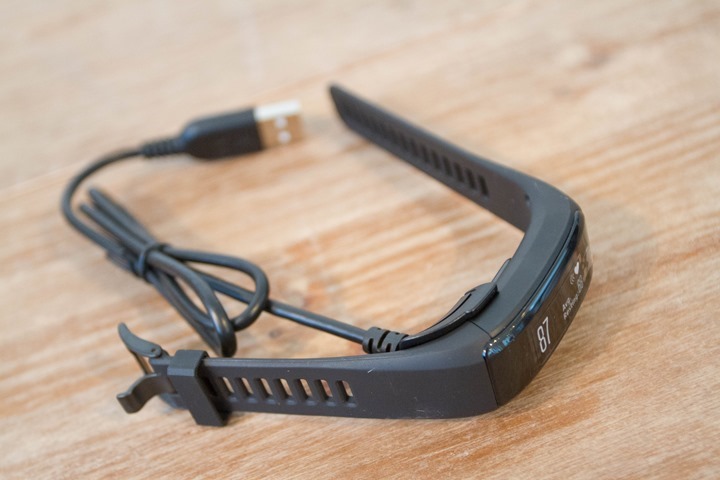










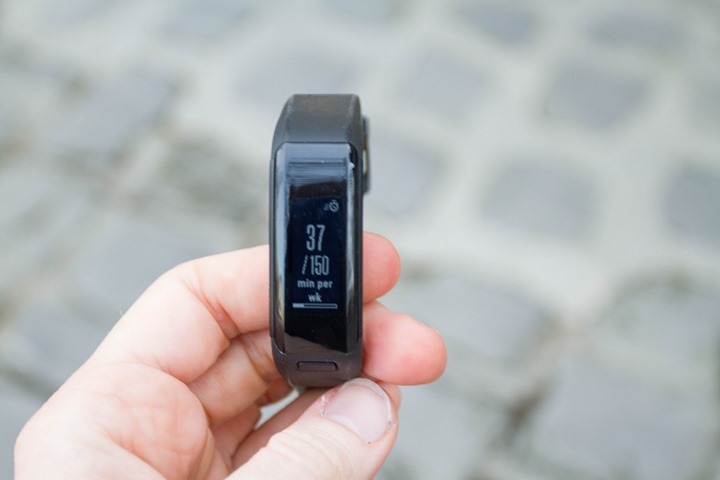



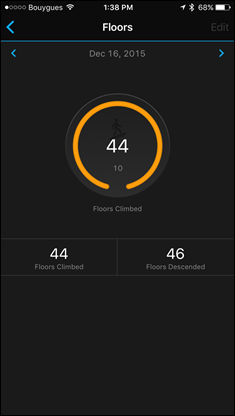






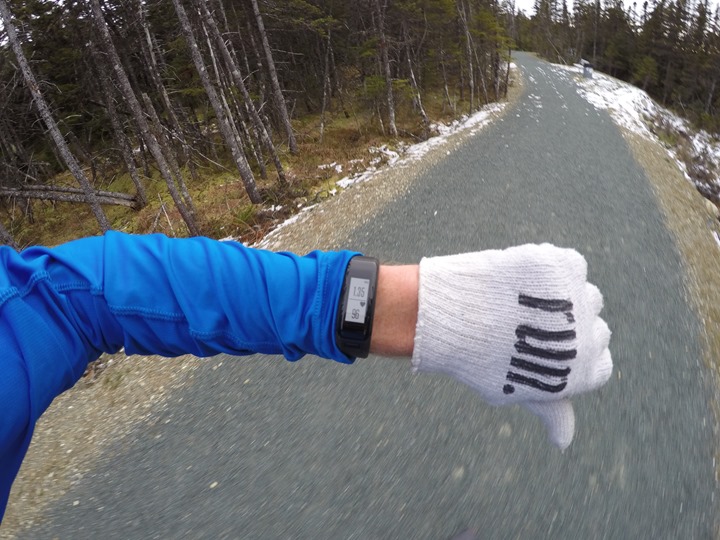
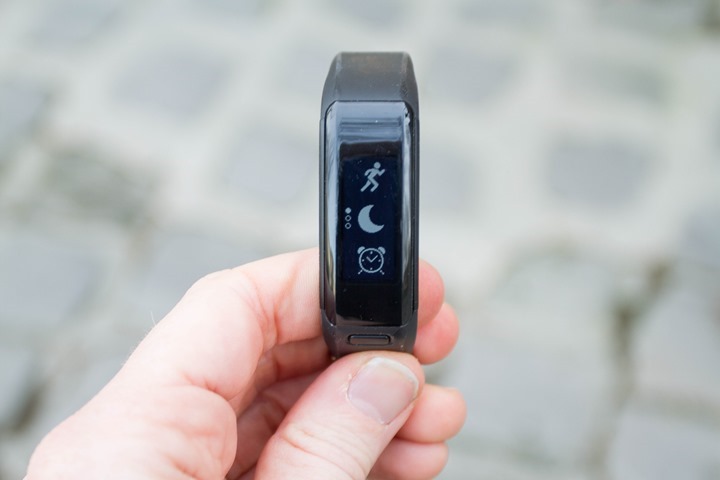
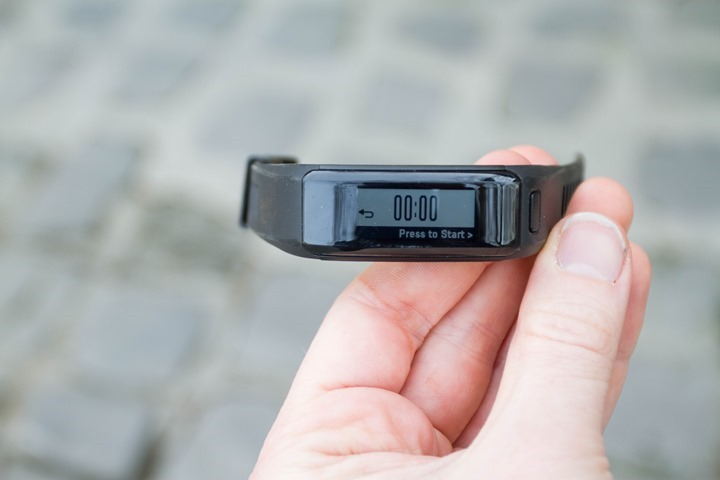


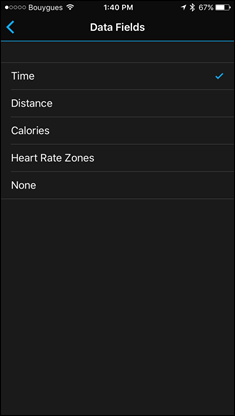









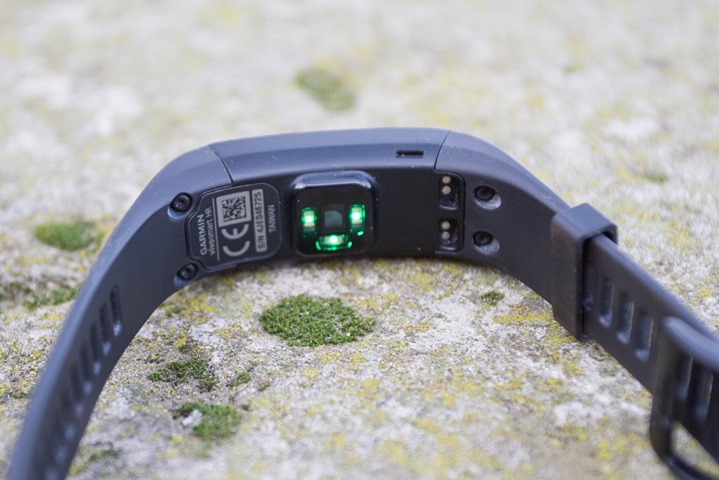
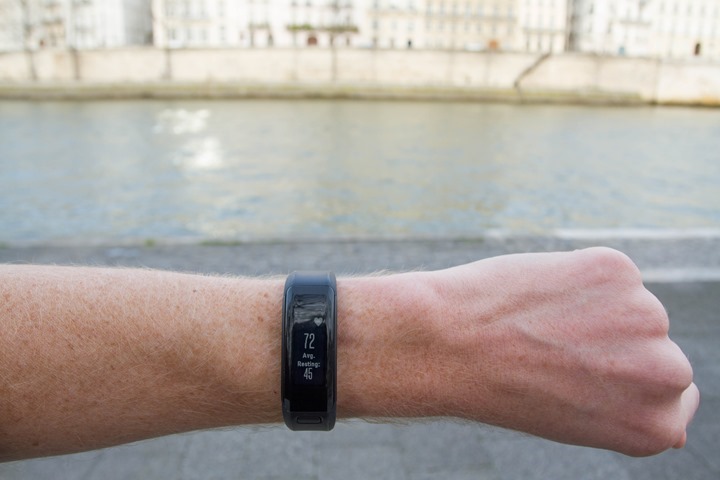



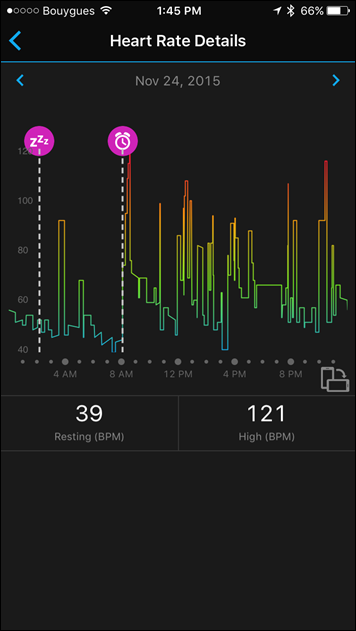










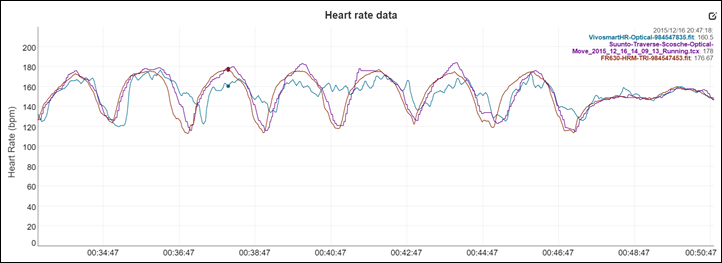
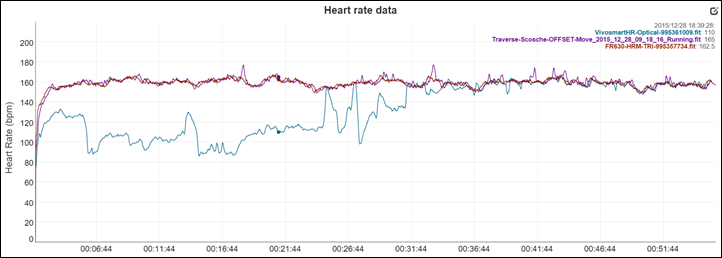





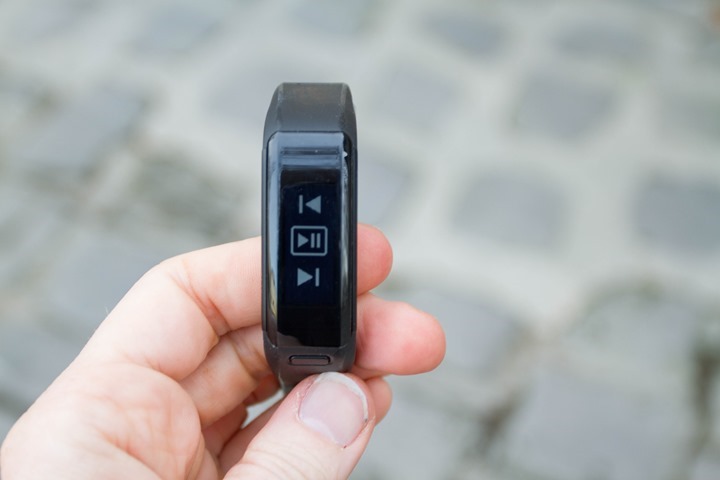

























I have a vivosmart ( not the HR) and this is now the second one I about to have to return because the battery stops working after charging it using an iPhone block . Is this because there is too much charge coming through compared to charging it on a computer? Very frustrating. Any fix you think?
Can we answer or reject incoming calls using this device?
My wife uses her vivosmart HR mainly for recording steps. She walks quite a lot pushing a baby stroller but finds the device seriously under records her steps compared to when she walks the same distance but with her arms by her side and swinging her arms in a relaxed way.
Is this a known problem? Is there any fix available?
Thanks Ray for the sterling work you are doing.
Hi,
Same happens with me & Fitbit HR. You just have to push one handed. No other way round it. I’ve tried swapping watch wrists but couldn’t steer while running with left hand! :-D
Hello, I’ve been reading a few of your reviews, and I have found them very helpful– so thank you. My question is about the heart rate zones with the Vivosmart HR. I just got this device a couple of days ago, and I’m still trying to figure things out. I was able to edit the HR zones based on the HRR. However, after a workout, I have not been able to see a chart/graph/table that shows how much time or percentage I was each of the zones during my workout. Do you know if this is possible with this device? It doesn’t make sense to me that you can set the zones but then there is no report on this following a workout. Perhaps I’m missing something? Thank you!
I really enjoyed the Garmin Vivofit HR but i had a problem with my skin.
It burns where the green light touches my skin.
I have asked a refund and now im searching for another watch.
I’m trying to set up the run screens, but my device won’t show me more than one stat per screen. I tried to set distance and time on the smart screen, but I have to flip between them. Any ideas? Thanks!
I love the unit I have one , but the strap is my only complaint , i will wear this for days , then all after a few days the unit hurts my wrist , i take it of and i find the strap had given me a rash of epic proportions that is similar to a burn , and i cant wear it for days after till my wrist heals
The band irritates me at times so I have taken to loosening it up 2 or 3 notches and sliding it farther up my arm. I usually move it twice a day and now have no issues.
What material is the screen? I broke on screen and Garmin replaced it for free, but now I’ve broken my second screen in 5 months of ownership. The product is cool, but it seems a little to weak.
Both times the screen has broken, I was outside during very hot days (first time it was 120 in the Mohave Desert, and the second it was 108 outside), and both times i noticed the screen had cracks was after apply spray on sun screen. It’s interested because in both instances the screen didn’t have one crack, but a few small cracks on the entire face of the watch.
I have the same problems, I hike in the desert by bullhead city az, and when I looked down at the garmin I noticed the cracking and chips , they got worst the next day . I think it is the high temperatures here was 106 that day
I received the Vivosmart HR for Christmas and really had no problems whatsoever until June. One day, after sitting int he sun (reading a book) for 2 – 3 hours, I noticed the screen seemed to have several small cracks or chips in it. Of course, Garmin assumes I smashed the screen somehow, so it cannot be replaced under warranty. Over the summer, I have been in the sun many more times and the screen is much worse. I know I have NEVER smashed the screen or dropped the watch or abused it in any way. I can only assume that it cannot withstand high temperatures that are generated by the sun shining on the dark watch face.
Curious, is it possible with the HR to connect to gps through your phone, like the Fitbit Blaze, no onboard gps but it uses your phone to track distance and route etc?
Vivosmart newbie here, first day!
Do other users keep the Garmin Connect App running 24×7 on their phones or just open it to sync with the Vivosmart periodically?
I just open the app to synch. And I do not use the phone notifications at all.
I like the fact that it is water resistant for around 50 meters (5 atm) which is perfect for swimmers. With automatic sleep tracking and smart notifications for calls, emails, sms, social apps, etc. I can say it’s a good deal. Plus it has do not disturb mode, silent vibrating alarm, find your phone function to track your phone. The only negative aspect is that it does not have a GPS sensor. However I track my cycling using ‘Strava’ app on my phone.
This review dings the vivosmart HR for its long, variable HR sampling rate that limits usefulness of the HR data, particular RHR. However, in your hands-on review of the vivosmart HR+, you mention firmware improvements that helped resolution and RHR for this and the HR+. I am curious if you have seen sufficient improvement in vivosmart HR’s sampling rate since your original review in January. (I read through Garmin’s release notes, and they are sufficiently high enough level that they do not say anything.)
It sounds like Garmin has improved it, based on what folks in comments have noted.
Hello everyone,
I use the VSHR to monitor calories, activities & HR whilst indoor rowing mainly. Realising that data is not 100% accurate but more for guidance. Data is also linked to MFP.
My concern is whether my arm movements when rowing are understood by the VSHR as constituting “steps” because if that is the case, as MFP credits number of steps with extra calories burned I suddenly wondered whether my “active” calories in fact included calories burned during say 30mn of indoor rowing AND the calories earned by apparent steps and credited by MFP. If so, I am misled by the number of cslories actually burned.
I wear the VSHR when rowing because I cannot connect my rower’s data directly to the VSHR and thus to my Garmin connect account.
Any thoughts gratefully received.
Alison, I wonder if this explanation helps you: the Vivosmart hr uses a generic heart rate calculation method to determine the calories you burn.
For the software to compute your calories it needs your weight, gender and activity class and of course your heart rate.
With regards to the arm movement during rowing being counted as steps, I am not sure, but I would doubt that. I would guess a way to find out is to compare step count before and after rowing. Or to track the activity for 30 mins and see what data come up.
When you say MFP, I guess you mean MyFitnessPal? If that is the case, then food/calories you input there will be computed in your Garmin Connect app while syncing is going on. You find the result of the computed calories in your Connect app as a calorie balance (active vs rest calories).
Hope that helps you.
Thanks Katherine, I must confess not being entirely “au fait” with My FP. Calories burnt never completely add up on both MFP and the Garmin connect App. Most recent discrepancy is between the Garmin app and the Vivosmart HR – up to 200 calorie difference (!). Also I did a test on a bike ride – vivosmart HR showed 533 cals. burnt and Edge 25 showed 427 cal. burnt, both devices recorded quasi-identical heart rates. Algorithm must be different. Good thing I use them for guidance generally rather than for hard-core fitness training.
One of the things I don’t like about my vivosmart is that it notifies you if you go too far from your phone. It’s made me turn notifications off entirely, since they are all-or-none.
Is the VSHR.. smarter? Either no bluetooth range notification, or one that can be defeated?
I have not seen it do that. I have seen the display pages that are tied to a phone connection sometimes show “No App Connection Available” (or words to that effect). So as far as I can tell, it does not produce any kind of notification in that event.
They updated the firmware earlier this year so you can turn the war in on/off independently of other notifications.
Does it show time and date?
It shows the time (24-hour format available, yay!), the day of the week and the day of the month. It doesn’t show the year, which seems like no loss at all.
My watch band has broken, does anyone know where I can get a replacement? The guys at Garmin don’t sell them.
Paul – I broke my band buckle and emailed Customer Support. They had me send pictures to determine if it was something they could send me. It was not so they had me send it in for repair. It was sent back promptly and has held up since. I had a good experience with Customer Support.
So my band broke and a couple days later the rectangular end of strap retainer broke also, they seem almost to have rotted, odd. Support said I would have to send the entire unit in and then a couple days later they said they would send a replacement band. I got an order notification for a black band (mine is blue and that was included in the support claim). The black band is on backorder until early November, not really impressed so far with Garmin support…
Note that you can ask Garmin to do what’s called a “cross-ship”, which means you give them a credit card, and they’ll send you a unit that day. You then send back your unit, and as long as they receive your unit in a preset time (it was roughly 30-45 days), then you don’t get charged for the new unit.
Don’t take it Scuba diving as warranty won’t cover it, even if it’s only for 30 minutes to 10m and protected under a wet suit despite having a 5 ATM rating (50m according to Garmin’s site, but 5atm is only 40m deep). Damn.
Great review thanks. I am using a Concept2 rowing machine as part of my fitness regime. Any thoughts on how/if I can track my workouts when using the rower. Thanks
Hi Philip,
I also use a concept2 rower but realised that my vivo HR was unable to “import” the data from the PM5 – probably because the vivo had its own HR. What i do is have a chest heart monitor connected to the PM5 of the rower (so as to log activity directly in the PM) but I also turn on the activity tracker on the Vivo under “other” or “cardio”, like that the activity, calories etc are synced to Garmin Connect & MFP. If you do discover a way to transfer data from the rower’s monitor to the garmin connect, I would be pleased to hear it. Best, Alison
Hi Alison, sorry not to come back sooner. My machine is about 4 years old so not sure if I have the ability to connect as you suggest. Also don’t understand how to find ‘other or cardio’ ….. Good luck with your fitness regime.
Philip, you press the button on the side of the vivosmart, then tap the “human” icon and swipe to “cardio” or “other”. Tap and then press the button again to start the timer. Re-press to stop and save. Good luck!
Re my previous post- I forgot to say I have been using the vivosmart HR for about 6 months after an old Polar Pacer because I hated the band.
Hello all,
I would be interested in having your opinion re: calorie burn accuracy,
I have vivosmart HR for daily activities & Edge 25 w/chest belt for cycling (so 2 Garmin devices). After a ride both devices record same if not identical readings for MHR and Average HR during the ride. However the Vivo indicates between 80 and 100 mor calories burnt than the Edge. Which reading is more accurate? thanks !
I’m surprised you didn’t have any complaints about the sleep tracking. I’ve found it to be woefully inaccurate and the Garmin Vivosmart seems to just mark down that I slept like a rock through whatever start and endtimes are configured regardless of what goes on. I’ve had several nights where I’ve woken up at 2-3am read or surfed twitter on my phone for an hour and then gone back to sleep only to have the Garmin report that I’ve slept for 10 hours like a rock all night! The activity tracking aspects of the vivosmart as a whole have been wildly disappointing and the insights feature seem to only give me thought provoking notifications like “You’re doing a lot of stuff today”.
Ultimately I think this device really fails it’s users, since I’m mainly using it as a poor man’s running watch now I should’ve just gotten the forerunner 230, for anyone looking for an actual activity tracker the fitbit runs laps around the garmin in terms of sleep tracking, having a beautiful UI, and more social and motivation features.
Battery life dramatically shortened. Has anyone else had problems with battery life over few last days? How should this be fixed? Mine Vivsmart HR dies in 24 hours but used to in 4-5 days. I suspect firmware update (3.80). Though I am not sure that the update happened few days ago or already earlier. In noticed from the Garmin’s website that there is a newer firmware update (3.90). I am not sure if it would solve the problem and I have not found the way to “force” firmware update.
Thanks
Can I swim using my vivosmart HR? Does it work?
I did not see this in any other comments but you are able to lock the screen in broadcast mode, so you don’t turn it off by accident. If you hold down the button for about 5 seconds a screen will pop up to lock the screen or turn it off.
I have a Gamin vivosmartHR + the day I purchased the watch I tried to charge the unit with a normal charger &the screen is blank since then tried resetting nil help
You’ve had the Vivosmart HR for awhile, long enough to comment on the band’s durability. I’ve seen two die already, each within the space of six or fewer months. Basically, the band comes unglued from the display portion of the device and a new one needs to be acquired, screwed onto its base and then re-attached to the display. Have you had such problems?
The band doesn’t appear to have been glued down. My band broke and I was sent a replacement. It was a simple job to remove the two screws on each side and put the new bands on. The band is material is stiff enough that it basically hooks over the display and is secured by the screws. The rectangular band end retention also broke (and on a friends also).
This is a very accurate review. I have one and like it, except the main reason I got it is the HR monitoring and it is all over the place. It is like it is lagging HR by maybe 20 seconds or more. My real HR can be up to 160 but the Garmin will be reading 130 or less. Then, I stop vigorous exercising and relax by breathing and the HR reading increases. It is almost like it is not instantaneous, rather sampling and applying some sort of average, even though there is already an average readout.
Its not suitable for instantaneous HR and it seems that only the chest strap types do this well.
I have the same problem with my new Garmin. I use it to track active calories after a workout. Initially my calories were 233 burned, via the app 2 hrs later I synced the garmin again and my calories were 545.. either the data has a lag in it and takes a while before the total will show..I dunno. Has anyone else had a problem like this? Or is this how it’s supposed to work?
I own this unit since three weeks and I’m happy so far.
I did an extensive search before buying this product, reading reviews, manuals, user feedback etc.
Main reason why I went with Vivosmart HR was its low price (100€), the ability to monitor HR during sleep and have a way to chart it across a date period. All this while keeping all radios off when sleeping!
Perfect so far and the way Garmin calculates rest heart rate falls in line exactly with my training stress level.
I only sync it/charge it one time each morning while I shower. This is enough to keep the battery fully charged at all times.
I used it a few times to broadcast HR to my Forerunner and was unimpressed, it works fine if keeping a steady pace but will nearly always ignore rapid hr changes.
Sleep detection is spot on and even stairs count is accurate, not that I care.
I accidentally found out this morning that if you press on the Heart rate screen for about 5 seconds it asks you if you want to enter Broadcast mode. Not sure when this started, but I am happy I don’t have to go into settings and find the broadcast mode every time I want to broadcast.
I appreciate how detailed your review is. Do you know if there is any guidance on wearing the device on your dominant or non-dominant wrist?
Great review. I agree that the HR function is its weak feature. I bought it for this, thinking it would replace my cheap $20 chest strap/watch, but it doesn’t. The other features are great, but HR is not accurate or fast enough in response to peaks in heart rate. I still use it, but will be looking at reviews to find a better one.
How do I delete files to open up room? The fit bit HR says the memory is full whenever I try to save my workout.
Thanks!
Will this be able to track exercise throughout the day? For example, say I stop to do 50 push-ups (I know, a bit optimistic ;) Will the Vivosmart HR know I was just exercising or will it only know that my heart rate increased?
Hi Ray, I got a vivosmart HR when they first came out, but hated it, both for the height of ot when on the wrist and the crappy hr monitoring, so I went back to my old vivosmart. Do you think Garmin are likely to do a visosmart2 HR any time soon? my old vivosmart is getting a bit long in the tooth.
It also happens to be one of the only options out there if you want to control the Bluetooth. I bought it specifically for that convenience!
I’m on my second one and I would suggest that they call the unit the VivoDumbHR-. When my HR indication constantly read typically 30 BPM higher than my actual HR during exercise, I called Garmin support. As an aside, I checked the accuracy of the HR reading both through comparing it to my manually taken HR and comparing it to one of my Garmin bicycle and/or running computers wearing a HR strap. Garmin told me that I should clean the back of the watch and clean my wrist and try again. I did with the same inaccurate HR reading results.
They sent me a new one, and it is just as inaccurate. I’m not sure if technology has reached the point where one can monitor HR with just a wrist device. I’ve had to high-end Fitbit watches and they were just as inaccurate unless I was sitting still.
If you want to accurately monitor HR, this is not the device for you!
My vivosmart hr goes into broadcast mode all the time on its own. Just have to go to pulse page, one swipe up and tap and hold to get in. It is easier than the menu path but annoying to find it broadcasting multiple times a day.
I purchased the Vivosmart HR for my wife about 18months ago and now the battery will not hold a charge. Went to replace battery but it seems that its not a self replacing battery. Seems odd that the Vivosmart only has a 18 month shelf life as I have over a dozen other Garmin devices that never have this issue. I’m told Garmin will replace for $89US (but I’m not in the US) but $89 seems a waste as there are better Garmin products on the market now. Has anyone else had this issue and has anyone tried replacing the battery. I’m happy to experiment and destroy it as its all but destroyed now anyway :-)
Oh yes, I cleaned the battery connecters but that didn’t work.
Thank you for this in-depth review. My sister and I just got one for our birthdays, and seeing the features displayed in pictures really helps. I’ve stumbled upon the article as I was searching whether it was safe for me to use an iPhone/iPad charger to charge the device. However, I did not notice this information. Do you know if it’s safe?
Yup, no problem.
Hi Ray!
Thanks for all the content.
I’m looking for a sleep tracker (with HR), and some connected features add up. Would you suggest this unit for 47 euros (amazon refurbished, like new)?
Aitor
47EUR would seem like a pretty darn solid deal to me. :)
The neat thing about refurbished units is that they come from the same factory as new units, just get new external casings and testings.
I brought this Garmin vivo smart 2 hr from
Verizon in July of 2016. I wear it every day.
I have never had problem with the garmin.
Yes it be off some steps ( when I cut the grass,
Because I am not moving my arm back n
Fore, it cannot read the steps). Yes I take shower
With no problem. I just check my battery meter,
So I can recharge it. Yes I would but another one, when it stop work. I give it 10 stars